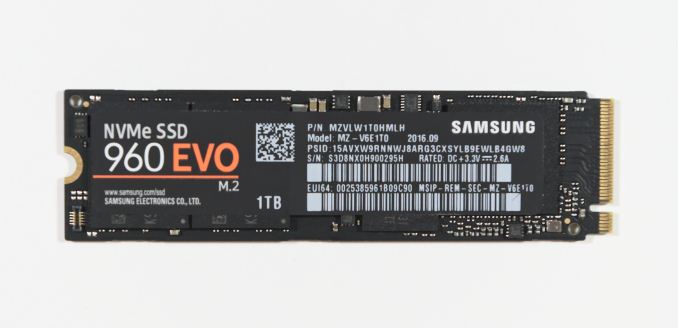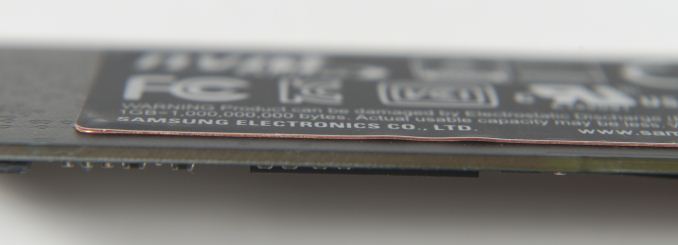The Samsung 960 EVO (1TB) Review
by Billy Tallis on November 15, 2016 10:00 AM EST
Last month the Samsung 960 Pro broke most of the performance records for a consumer SSD and often by a surprisingly large margin. But as impressive as it was to see the combination of high capacity and high performance in such a small package, the 2TB 960 Pro we reviewed is too expensive to be a realistic option for most enthusiasts.
Enter the Samsung 960 EVO. With the same powerful SSD controller used on the 960 Pro but much cheaper TLC 3D NAND, the 960 EVO is far more affordable but promises similar peak performance. Despite being Samsung's low-end M.2 PCIe option, the 960 EVO is aiming to outperform last year's 950 Pro and the current flagship PCIe SSDs from Samsung's competitors.
| Samsung 960 EVO Specifications Comparison | ||||||
| 960 EVO 1TB |
960 EVO 500GB | 960 EVO 250GB | 950 PRO 512GB |
950 PRO 256GB |
||
| Form Factor | single-sided M.2 2280 |
single-sided M.2 2280 |
||||
| Controller | Samsung Polaris | Samsung UBX | ||||
| Interface | PCIe 3.0 x4 | |||||
| NAND | Samsung 48-layer 256Gb TLC V-NAND |
Samsung 32-layer 128Gbit MLC V-NAND |
||||
| SLC Cache Size | 42GB | 22 GB | 13GB | N/A | ||
| Sequential Read | 3200 MB/s | 3200 MB/s | 3200 MB/s | 2500 MB/s | 2200 MB/s | |
| Sequential Write (SLC Cache) | 1900 MB/s | 1800 MB/s | 1500 MB/s | 1500 MB/s | 900 MB/s | |
| Sequential Write (sustained) | 1200 MB/s | 600 MB/s | 300 MB/s | N/A | N/A | |
| 4KB Random Read (QD32) | 380k IOPS | 330k IOPS | 330k IOPS | 300k IOPS | 270k IOPS | |
| 4KB Random Write (QD32) | 360k IOPS | 330k IOPS | 300k IOPS | 110k IOPS | 85k IOPS | |
| Power | 5.7W (average) |
5.4W (average) |
5.3W (average) |
7.0W (burst) 5.7W (average) 1.7W (idle) |
6.4W (burst) 5.1 (average) 1.7W (idle) |
|
| Endurance | 400TB | 200TB | 100TB | 400TB | 200TB | |
| Warranty | 3 Year | 5 Year | ||||
| Launch MSRP | $479.99 | $249.99 | $129.88 | $350 | $200 | |
The 960 EVO is not the first M.2 PCIe SSD to use TLC NAND. Samsung's OEM product line has the PM951 and PM961, using the same controllers as the 950 Pro and 960 Pro respectively. Intel has also shipped the 600p as their first 3D NAND SSD for the consumer market, but the Silicon Motion controller it uses is a far cry from the monster of a controller used in their flagship SSD 750.
As a more cost-focused product than the 960 Pro, the 960 EVO has a lower range of capacity options. With a maximum capacity of 1TB, the 960 EVO does not need to use the controller+DRAM package on package stacking that was necessary for the 2TB 960 Pro to be a single-sided M.2 module. As is normal for Samsung's EVO lines, the usable capacities are a bit smaller, with the 1TB EVO being 1000GB instead of 1024GB.
Some of the extra spare area reserved is used for the SLC write cache, which Samsung is now branding as 'Intelligent TurboWrite'. Where the 850 EVO's TurboWrite cache was 3-12GB depending on drive capacity, the 960 EVO has 4-6GB of guaranteed cache plus 9-36GB of dynamic cache when the drive has sufficient free space. Having a cache that is several times larger will greatly expand the range of workloads that can fit in the cache, and will help the 960 EVO make the best of its PCIe 3.0 x4 interface that is much faster than SATA.

Spot the copper-backed heat spreader label underneath
The 960 EVO includes all of the thermal management measures of the 960 Pro, including the copper-backed heat spreading label, a very power-efficient controller and a well-tuned thermal throttling implementation. TLC NAND has been shown to be, in general, slower and more power-hungry than MLC NAND so the 960 EVO is more susceptible to thermal throttling than the 960 Pro, but Samsung claims it is still less of a problem than it was for the 950 Pro, which means that virtually all real-world usage scenarios will not trigger throttling.
The warranty period for the 960 EVO is three years instead of the five enjoyed by the 850 EVO and both generations of MLC-based PCIe SSDs. The drive write endurance rating is also only half that of the 960 and 950 Pros, but 100TB for a 250GB drive is a sufficient amount.
For this review, Samsung provided an advance copy of their new NVMe driver version 2.0 to support the 960 Pro and 960 EVO as well as the 950 Pro. The 960 EVO was tested with Samsung's driver and the 960 Pro was also re-tested using this driver instead of Microsoft's driver built in to Windows. The results for the 950 Pro are still from version 1.0 of Samsung's NVMe driver. The next major release of Samsung's Magician software is still not quite ready, so exploration of encryption capabilities and other new features will have to wait. Samsung expects to release Magician 5 by the end of the month.
Samsung provided a 250GB 960 EVO and a 1TB 960 EVO for this review. The 250GB 960 EVO failed relatively early in the testing process, after completing a few of the IOmeter tests and while it was about 10% of the way through being filled to prepare for the next test. We are working with Samsung to determine the cause of the failure but due to the short time available we have not been able to reach a conclusion as of press time. These review units are technically preproduction samples and thus their failure rates are probably not indicative of the mass-market reliability. SSD deaths are nothing new at AnandTech, and in the past some of them have been our fault rather than due to defective goods. But regardless of what triggered this failure, there is a bright side: our testing usually doesn't tell us anything about the end-of-life behavior of SSDs. If our 250GB 960 EVO has indeed failed unrecoverably, it did so gracefully: the drive entered a read-only state during the fill process, which caused IOmeter to hang, but the data already written is still accessible and the drive still reports its SMART indicators and error codes. Aside from refusing to accept write or secure erase commands, the only symptom of the drive's failure is higher than normal idle power consumption.
For this review, the 1TB 960 EVO will be compared to the 2TB 960 Pro, last year's 950 Pro, and the current flagship NVMe drives from Intel and Toshiba (OCZ). For context, results from several 1TB SATA SSDs are also included. As always, our Bench tool can be used to compare against any other drive in our database of test results.
| AnandTech 2015 SSD Test System | |
| CPU | Intel Core i7-4770K running at 3.5GHz (Turbo & EIST enabled, C-states disabled) |
| Motherboard | ASUS Z97 Pro (BIOS 2701) |
| Chipset | Intel Z97 |
| Memory | Corsair Vengeance DDR3-1866 2x8GB (9-10-9-27 2T) |
| Graphics | Intel HD Graphics 4600 |
| Desktop Resolution | 1920 x 1200 |
| OS | Windows 8.1 x64 |
- Thanks to Intel for the Core i7-4770K CPU
- Thanks to ASUS for the Z97 Deluxe motherboard
- Thanks to Corsair for the Vengeance 16GB DDR3-1866 DRAM kit, RM750 power supply, Carbide 200R case, and Hydro H60 CPU cooler











87 Comments
View All Comments
DanNeely - Tuesday, November 15, 2016 - link
The Intel 750 doesn't have power data in Bench. My guess would be that the current power benchmarks post-date when the review sample was returned.Sometimes there are oversights, but most of the time when some devices are only shown in a subset of the charts its because data to score them on the others isn't available. Most often due to moving testsuite targets or breaking changes in the benchmark applications.
http://www.anandtech.com/bench/SSD15/1440
http://www.anandtech.com/bench/product/1458
Billy Tallis - Tuesday, November 15, 2016 - link
Yeah, the Intel 750 was tested by Kristian before we had working PCIe power measurement. It also complicates things by using both the 12V and 3.3V rails, when I only have one meter. Adding power consumption data isn't a high priority for me, because the Intel 750 is always in last place, by a lot: its idle power is higher than the load power of most M.2 drives on many of the tests. The Intel 750 would distort the scale of the power graphs to the point that it would be hard to see the differences between the M.2 drives.willis936 - Tuesday, November 15, 2016 - link
How are M.2 drives mounted during these reviews? Do you use the motherboard's M.2 connector? A PCIe adapter without a heatsink? A PCIe adapter with a heatsink?Billy Tallis - Tuesday, November 15, 2016 - link
Unless otherwise specified, M.2 PCIe drives are tested in a simple Lycom DT-120 adapter, which is connected to the riser card used for power measurement, which is in turn connected to the primary PCIe 3.0 x16 slot. Drives like the OCZ RD400A and Plextor M8PeY are also tested in their bundled adapter cards with whatever heatsink that provides, and any other M.2+heatsink results I report are using the Angelbird Wings PX1 adapter and heatsink.R3MF - Tuesday, November 15, 2016 - link
Is that v2.0 driver available on day one?(for Windows7 users wanting to do a fresh install)
CrazyElf - Tuesday, November 15, 2016 - link
First, it is the drive that will likely play a role in making M.2 SSDs a much more popular form factor, perhaps to the point where NVMe drives overtake SATA. Most people do not need the write endurance that the MLC SSDs have.Second, the performance is quite good, and although there is still a huge price premium over SATA SSDs, the massive performance increase is much more justifiable in terms of cost premium compared to say, the 960 Pro, which is for people who want the best. It will remain that way, until the 970 Pro and Evo come out, or perhaps until a 3D XPoint SSD comes out.
Third, I expect an enterprise version to come out too, with power loss protection. The only real issue i see is if there is something like the 840 Evo that caused performance drops, but so far Samsung's TLC drives since then have been solid.
TheinsanegamerN - Tuesday, November 15, 2016 - link
I believe the 840 evo was planar NAND, whereas the newer designs are 3D NAND. That may be part of the reason.XabanakFanatik - Tuesday, November 15, 2016 - link
I see no mention of Samsung's silent delays of these drives. As of now most models of both the pro and evo are listed as ship by late December or January.Kind of disappointing you would gloss over a 2-3 month delay like that.
haukionkannel - Tuesday, November 15, 2016 - link
It seems that Samsung was lucky that their 250GB unit did fail...http://www.tomshardware.com/reviews/samsung-960-ev...
It seems to completely another series than 1Tb version.
TheinsanegamerN - Tuesday, November 15, 2016 - link
What are you trying to say here?